Crafting an effective digital customer experience (CX) strategy is not just important—it's essential. A superior digital CX can lead to increased customer retention, higher conversion rates, and ultimately, business growth.
With the hands-on advice from our Director of Sales & Customer Success, Eylül Nowakowska Beyazıt, this blog post aims to guide you through the process of creating a digital CX strategy that exceeds customer expectations.
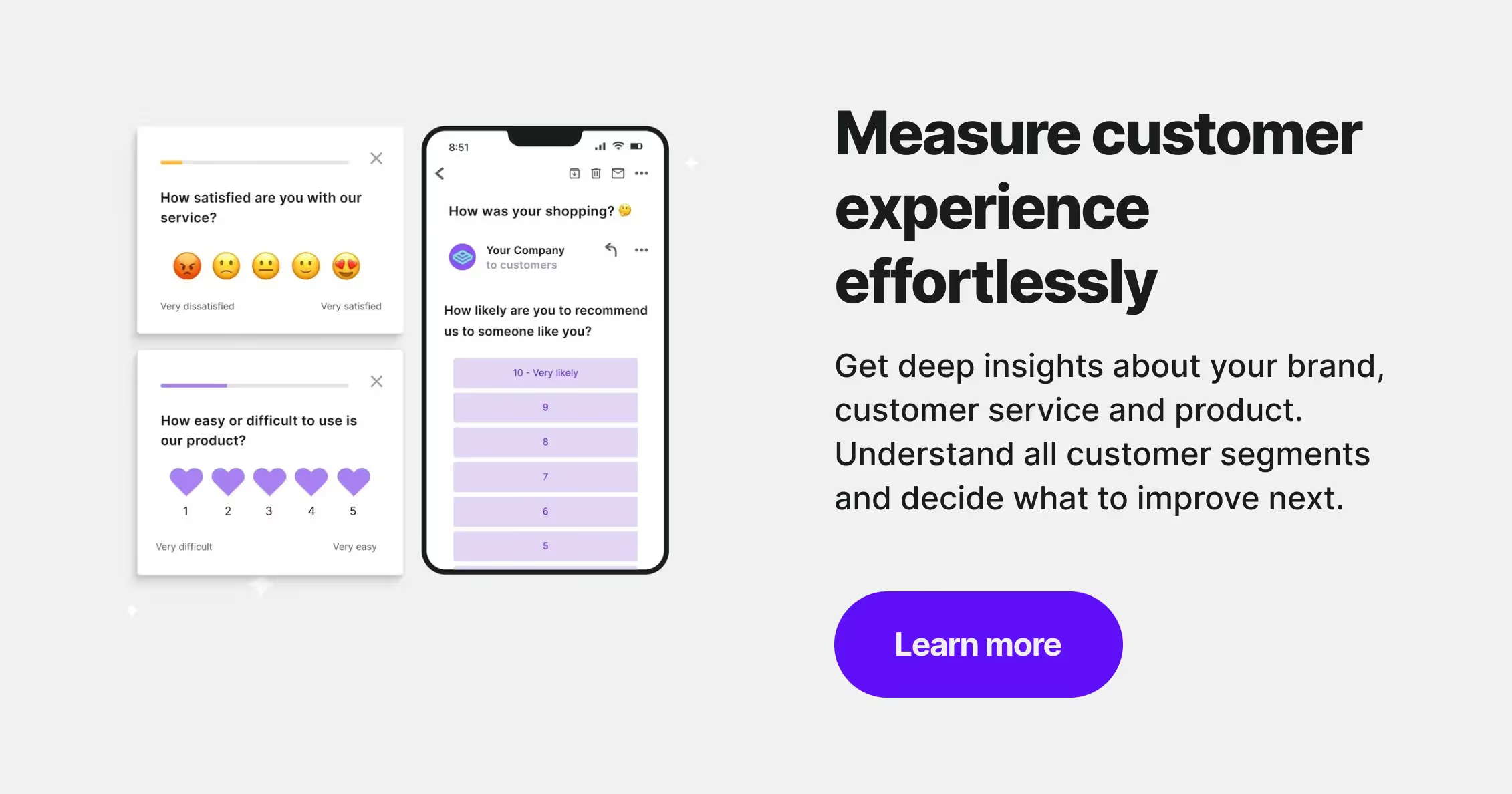
Why is a digital customer experience strategy important?
A digital customer experience strategy is critical because it directly influences customer loyalty and advocacy. In a market where consumers have endless options at their fingertips, a positive digital interaction can be the deciding factor in choosing your brand over a competitor. Here's why a well-crafted strategy is indispensable.
Meets customer expectations
Modern consumers expect seamless, intuitive, and personalized interactions with brands. A strategic approach ensures you meet these expectations across all digital channels.
Drives conversion rates
A satisfying digital experience can effectively guide potential customers through the sales funnel, leading to higher conversion rates and increased revenue.
Fosters brand loyalty
Consistently positive digital interactions build trust and loyalty, making customers more likely to return and recommend your brand to others.
Gathers actionable insights
Implementing a strategy allows for the collection and analysis of customer data, providing insights that can inform business decisions and drive growth.
Enhances competitive edge
A superior digital customer experience can set your brand apart from competitors, making it a key differentiator in your industry.
Reduces customer churn
By identifying and addressing pain points in the digital journey, you can reduce the likelihood of customers abandoning your brand for a competitor.
How to create a customer experience strategy that works?
Join our in-house expert, Eylül Nowakowska Beyazıt, who shares her proven tips on how to create and polish your customer experience strategy in a way that actually works.
We divide the list into three main parts:
- Collecting feedback along the entire customer journey
- Acting upon feedback
- Building a customer-centric organization from within

Map out your customer journey
You should already have this by now, but since it's a new year and a new me, use this opportunity to check and renew it.
Detail each step of the customer's journey, from the moment potential customers become aware of your brand to the point of purchase and beyond. Identify all the digital touchpoints—like social media, your website, email, and mobile apps—and consider the customer's intent and feelings at each stage.
Customer journey mapping should highlight where customers experience friction or delight, providing a clear indication of where to focus your improvement efforts. An all-encompassing customer journey map is an invaluable tool for visualizing the customer's experience and identifying opportunities for making it better.
Run customer lifecycle surveys
"Set up customer pulse surveys. It doesn’t really matter if it's NPS or CSAT. The key here is to do it on a regular cadence."
Eylül Nowakowska Beyazıt, Director of Sales & CS at Survicate
As Eylül mentioned, you can use NPS or CSAT, however be mindful about the context in which you set them up. If choosing between NPS and customer satisfaction survey confuses you, check our NPS vs. CSAT blog post or head to Eylül's LinkedIn, where she gives you a tl;dr.
You can add more questions to the survey, leaving the main question first. Software, such as Survicate, collects partial responses too, so even if your customers don't fill out the whole survey, you'll still have the main information in place.
The goal of this type of survey is to build a trendline, which you can use to support your further actions or strategy development.
wetter.com, Germany's most popular weather portal, sends an NPS survey every month to build a baseline for long-term user satisfaction.
“You need to start somewhere and then see the baseline. Our business depends on the weather, so our users are probably less satisfied on rainy days. It’s quite the opposite when it’s sunny. We can see this in the surveys, but we needed a year or two to establish a baseline. User satisfaction went up in summer and down a bit in winter. Now we know it’s a normal trend.”
Falco Kübler, Senior Product Owner at wetter.com
Run microsurveys after every major milestone
Microsurveys are a great way to learn more about the customer experience you provide. Set them up after every major milestone like onboarding, purchase, or using a new product feature.
The reason we have implemented Survicate is the ability to get user feedback in a given context. So, as opposed to the more standard way of fielding surveys, sending an email to invite users to answer several questions, Survicate allows us to get feedback on the particular experience of the site or the app as the user is experiencing it, which makes the answers much more contextual and accurate.
Sandrine Veillet, VP of Global Product at Medscape
Ground rules to make microsurveys effective:
- Focus on one topic only (for example, evaluate your purchase experience)
- Use as few open-ended questions as possible
- Target your surveys to get data from the most meaningful customer data
- Integrate your microsurveys with your tool stack for a bigger impact
Survey churned customers
You will not keep all of the customers who sign up for your product, even if you already provide a great digital customer experience. What you can (and should) do is survey churned customers to understand why they left.
It might be the last opportunity to learn from them, and it's yet another opportunity to evaluate your customer experience strategy.
Ask for evaluation after every interaction with the customer support team
Every time an interaction with one of your support agents closes, add a “How did we do?” email afterward.
We always ask for feedback after every parking session. As soon as a parking action has been completed, we will send out a survey to ask about the recent experience of the parker. The questions are related to the process from A to Z. Starting from the online booking process, opening barriers via our app until the on-site experience in the car park. There are thousands of responses every month.
Louise Alberg, Customer Service Manager at ParkBee
💡 Tip: If you use a customer service tool such as Intercom or Zendesk for support tickets, you can integrate your survey tool—for example, Survicate—with it and automate the survey distribution. Additionally, your contacts will be automatically populated with feedback.
Run feature request surveys
“What we should build next” surveys, your customers can be a great source of influence for your roadmap. It obviously shouldn't rule the product roadmap, but you're building for your customer base, and such a survey can be a factor when your Product team is prioritizing potential new features.

💡Tip: you can also set up a general feedback widget with an option for sharing feature ideas. That's how we do it in Survicate's admin panel. This way, you open your organization to receive spontaneous feedback from your customer base.
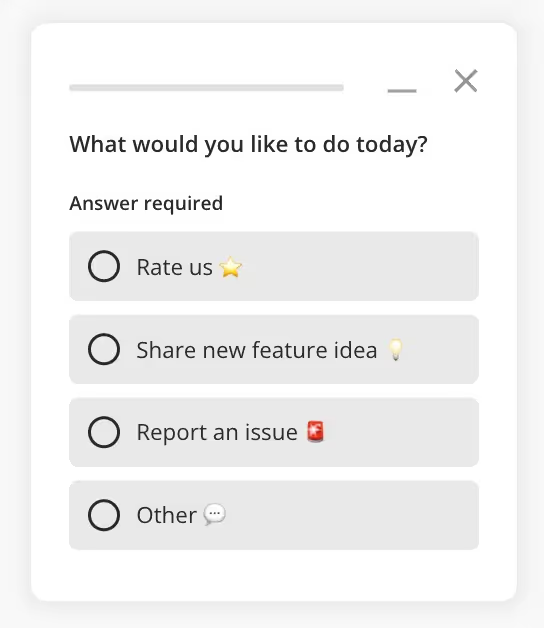
Create a feedback button
Let your customers leave feedback when they want to. A feedback button (or widget) is an always-on button on your website or inside your web app that collects unprompted feedback.
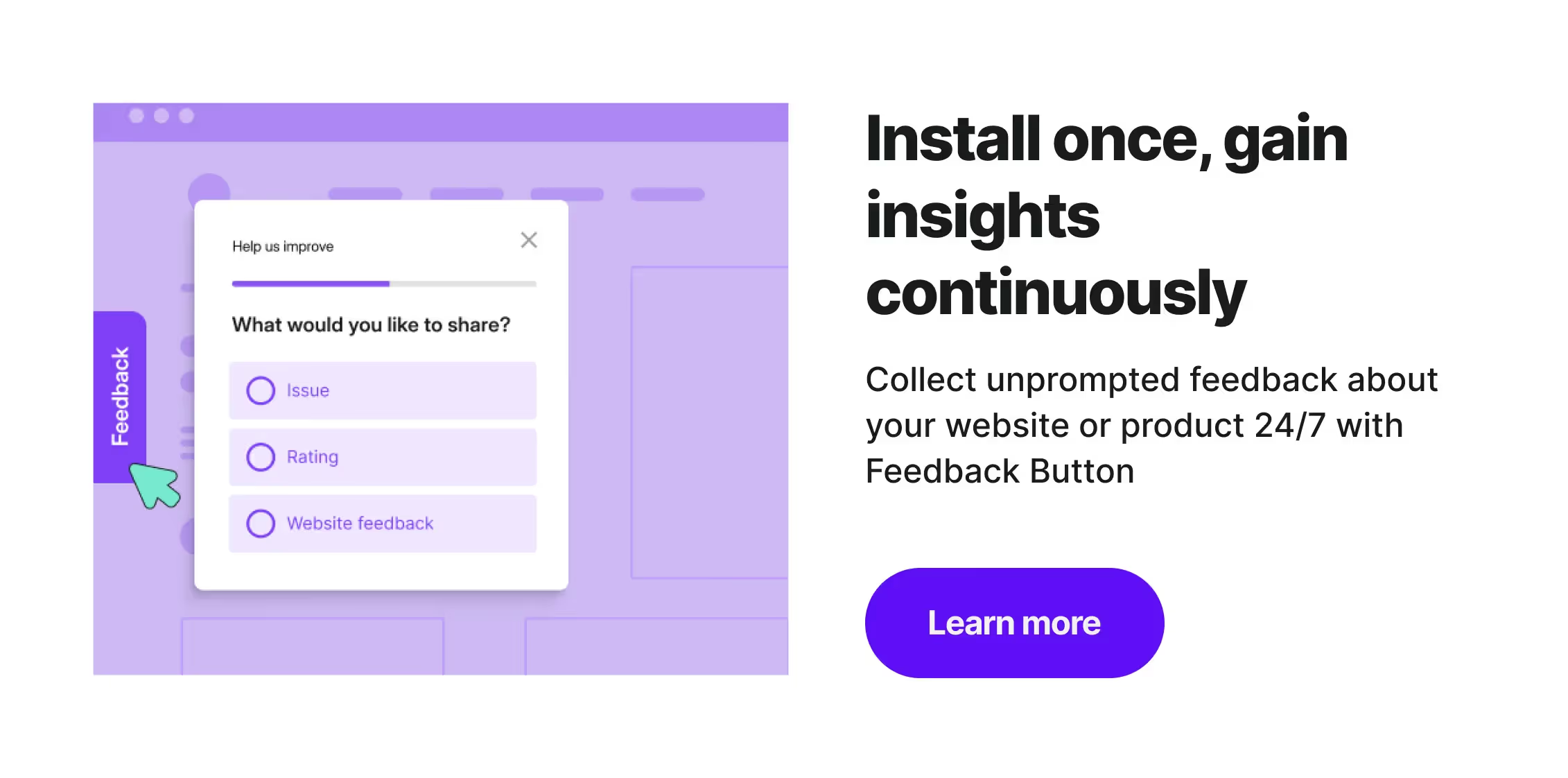
“Feedback button uncovered things that we wouldn't know about otherwise. There was one thing that was affecting many people that I had never experienced. No one on our team had experienced it either."
Katherine Crutchfield, Former UXR Lead at Landing
💡 Tip: Survicate allows you to set up multiple different feedback buttons depending on where you place them. This way, you can better customize your questions and get more relevant responses.

Collect and share social proof
While building a successful customer experience strategy, you should know your happy customers can make all the difference. Share their stories. There are several ways of how you can achieve it. Let's see some real-life examples.
Wahi, a Toronto-based prop-tech company, automated the collection of testimonials and reviews based on positive customer feedback with the Survicate-HubSpot integration.
Basically, every time positive feedback is given, the Marketing team is notified and can decide whether to pursue a bigger story with that customer. This makes the team much more agile in bringing social proof live and helps develop brand awareness.
With all the integrations we have, we can know firsthand when really good feedback has been given and act upon it very quickly.
Lydia Ku, Head of Marketing at Wahi
Pranamat, another Survicate customer, bases its marketing strategy on an ambassador program, so social proof is crucial for them. Using the Survicate-ActiveCampaign integration, they run a transactional NPS survey after each purchase and invite promoters to their ambassador program.
The most important and interesting thing for us is that we see growth in our affiliate network because we automatically invite all these promoters to become our ambassadors and promote our product. We also ask them to leave reviews on Facebook if there is a high promoter rate.
Aleksejs Krūmiņš, Head of Growth Marketing at Pranamat
As social media channels are key for Pranamat's efforts, customers are invited to share reviews on the company's Facebook account.
Keep all your feedback in one place
This is a biggie. If you want to effectively manage your customer feedback (and you should because it's the bottom-line of any customer experience strategy that works), you have to take it into account in its entirety.
There are many tools that do it, but for starters even a Google sheet will do. If you want something more advanced, Survicate's Insights Hub is something to explore.
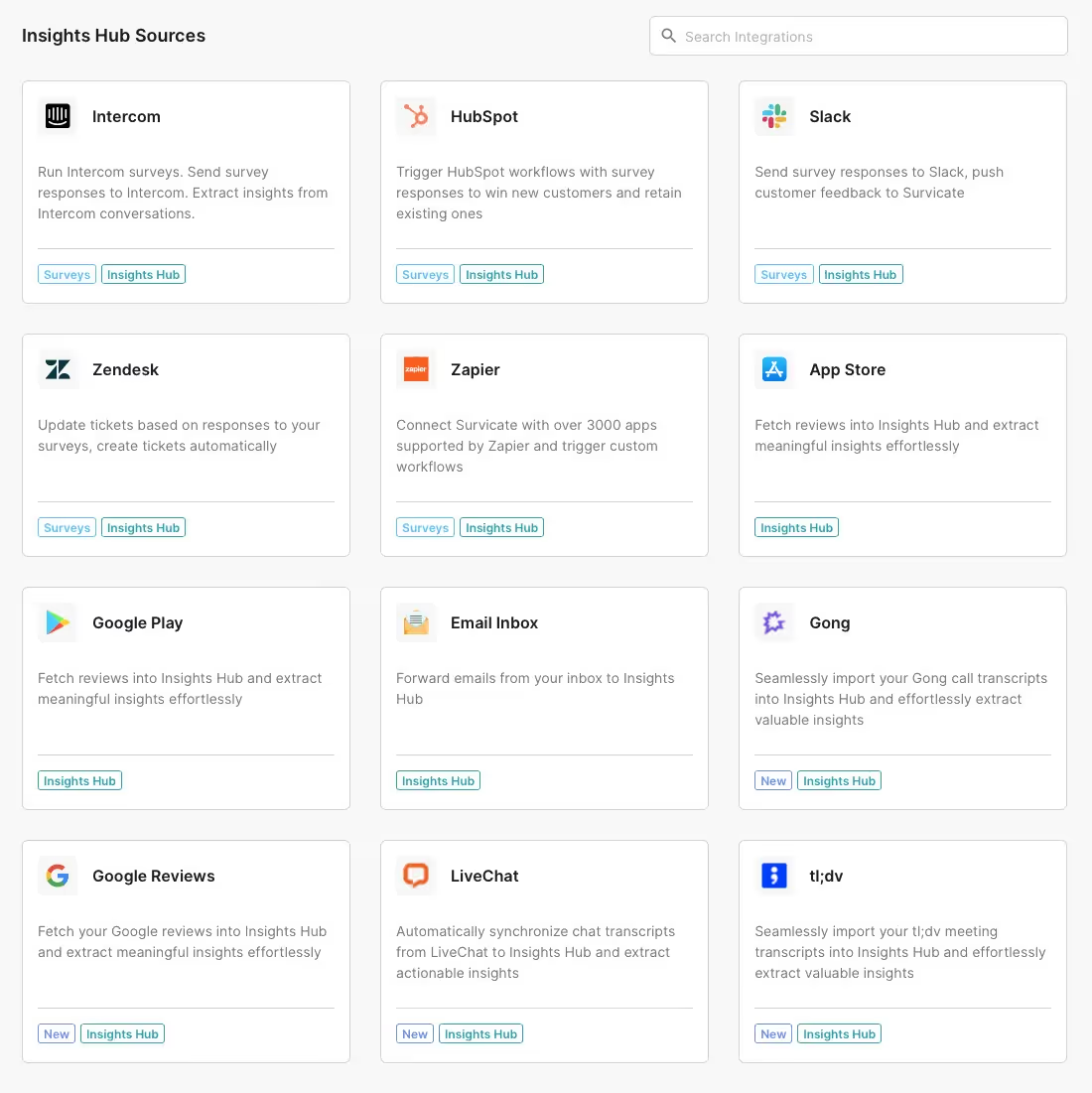
You simply connect your feedback sources (customer support team interactions, calls, surveys, online reviews, and more) and watch how they get automatically aggregated into topics. Apart from that, this AI tool also evaluates the sentiment of each piece of incoming feedback.
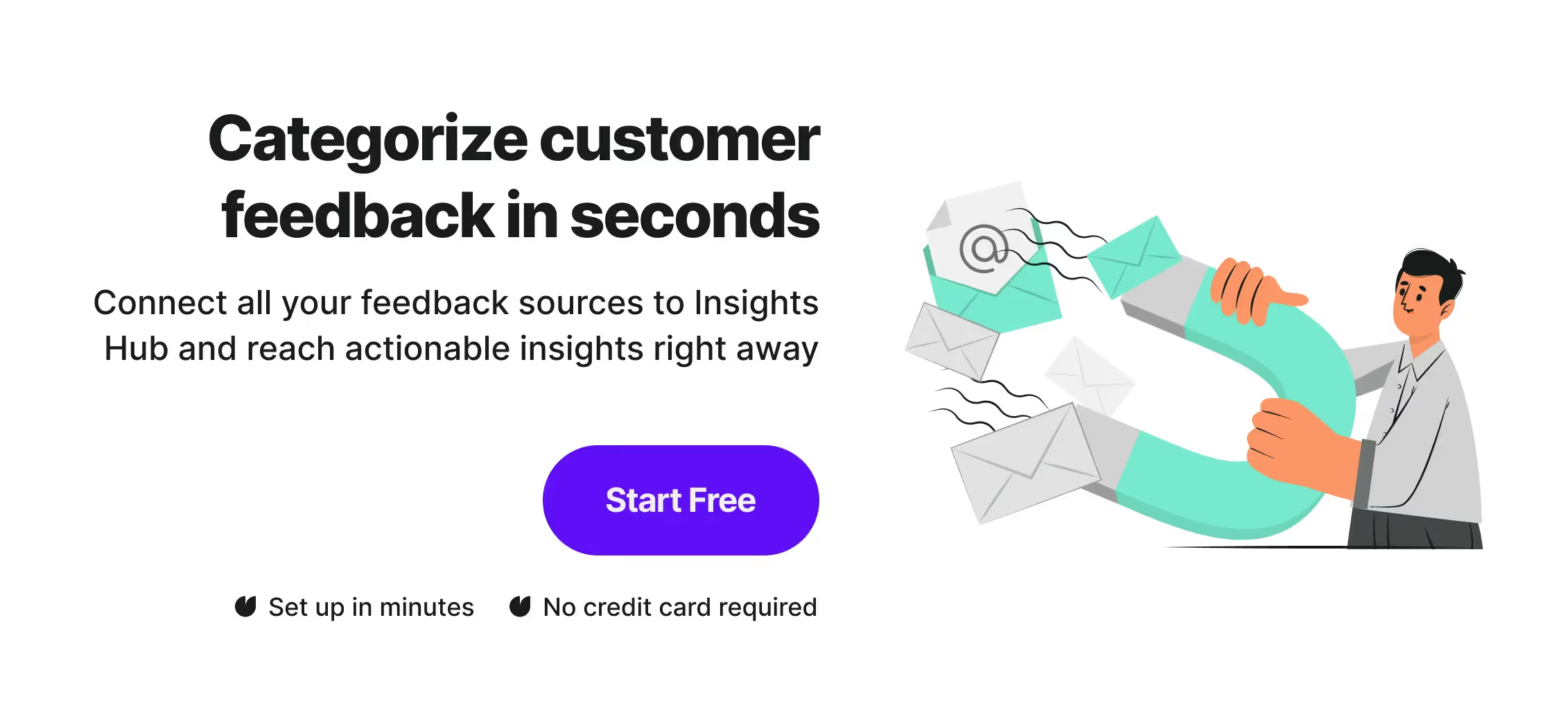
Use AI for feedback analysis
If you've been in business before 2024, you know just how tedious it was to analyze qualitative feedback. The nightmare is over, though. Now, you just need the right AI-powered tool to go through all your feedback in milliseconds and bring answers to the table.
Yes, we absolutely encourage you to use AI tools to summarize and analyze open-ended survey responses. Again, you can start with ChatGPT, but if you need something more secure, and precise for that matter, you can try Research Assistant.
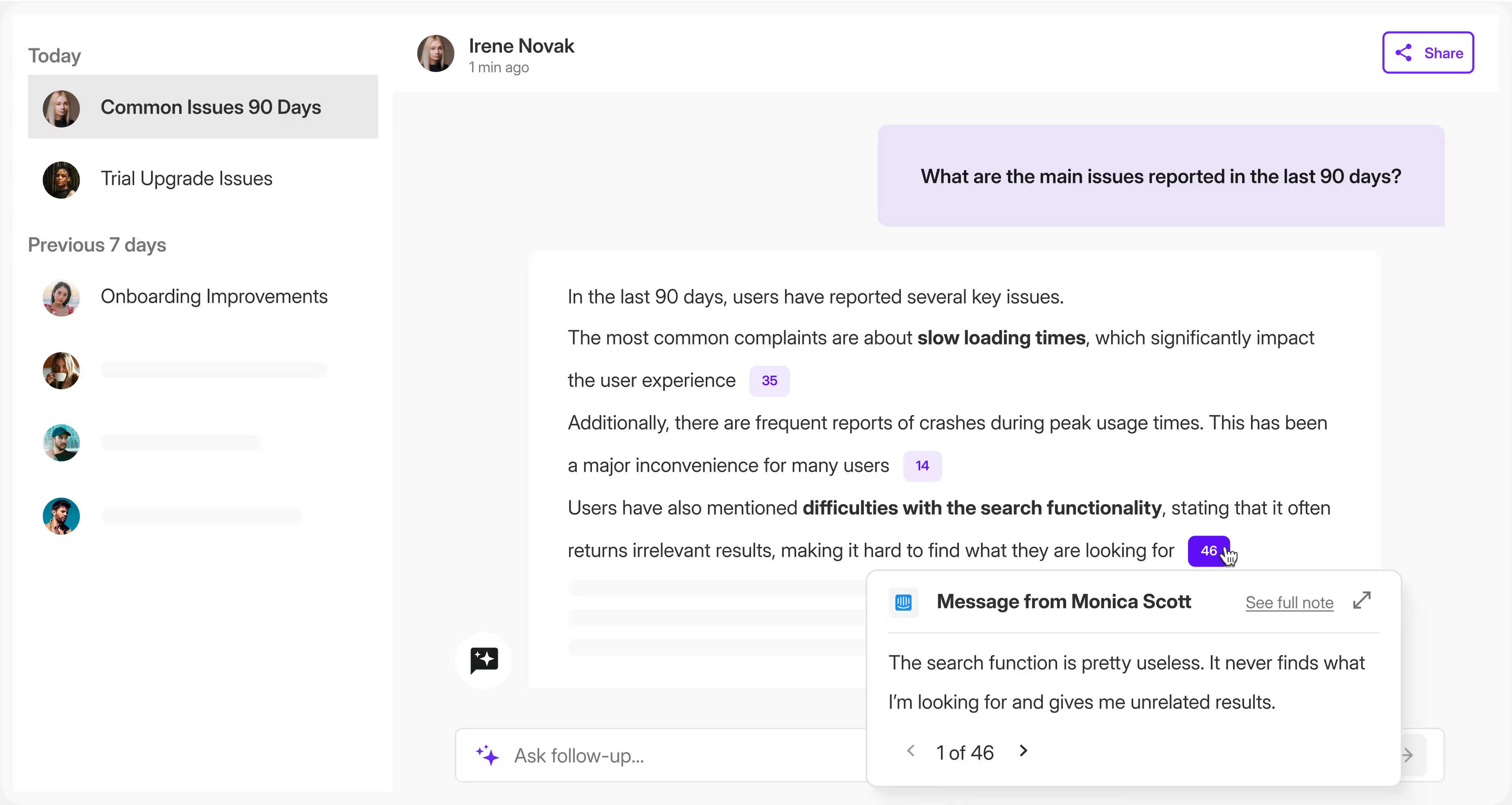
At first glance, it's similar to ChatGPT, probably because it's also an AI-powered chat. The difference is that it only uses the feedback you uploaded to Insights Hub as operational data. It means that when you ask it a question, it will only use your feedback as a source. What's more, it will show you the exact feedback pieces, so you can track them to the source effortlessly.

2025 is high time you start using the time to actually solve customer problems instead of trying to track them down.
Evaluate the effectiveness of your self-service resources
Delivering customer satisfaction consists of those small yet thoughtful actions, and evaluating your self-service resources is one of them.
"If you have a help center, content library, or an academy you need to constantly be evaluating how customers perceive the content you have there."
Eylül Nowakowska Beyazıt, Director of Sales & CS at Survicate
💡Tip: You can run web microsurveys that ask if the content is relevant or if it solves customer problems.
Create a top 5 fix-it list
When your company enters the truly customer-centric era, it's when you see the team silos crash. And that's when the cross-functional collab starts. No matter who owns the feedback collection, multiple teams can make use of it.
Meet with your product team monthly to tackle the top 5 recurring issues from customer feedback. This list helps you prioritize the most common or impactful issues your customers raise. Fixing even a few pain points consistently sends a powerful message to your customers: you’re not just listening, you’re taking action. Over time, this approach can massively improve the overall experience and boost customer loyalty.
Eylül Nowakowska Beyazıt, Director of Sales & CS at Survicate
The list will give your Product team an idea what improvements and bug fixes should be prioritized on the roadmap. And as an ongoing process, it will also show how fast your product changes to bring a seamless experience.

Democratize access to survey results
If you haven't done it before, the first thing you need to do is enable access to what your customers say for the whole organization. Feedback works best if it lives.
One of the low-effort ideas is to create a dedicated feedback channel within your company comms tool.
Create a space for feedback in the company communication channel. Whether it's Slack or Microsoft Teams, create a space for it and invite everyone. A key point for customer feedback is to make sure it’s heard.
Eylül Nowakowska Beyazıt, Director of Sales & CS at Survicate
Survicate customers often do this. Take Preply, a global language learning marketplace. As soon as they integrated Survicate with Slack, multiple product ideas emerged, and discussions centered on users' feelings about the product ensued.
“Our Product teams started a Slack channel to get sentiment about their product. They're discussing it on an ongoing basis and can comment on the feedback they get on the thread. This is really cool.”
Kateryna Martynova, Head of Research at Preply
Make sure survey insights are visible
Turn survey insights into a quarterly state of CX report. Also, make this a part of town hall meetings.
Eylül Nowakowska Beyazıt, Director of Sales & CS at Survicate
Go a step further—not only enable access to feedback but share the most important insights in a regular report.
Highlighting the voice of the customer, showing customer needs, and changes in high-level metrics such as NPS, CSAT, and CES can inspire the leadership team to invest more resources into customer experience management. Especially if you show the correlation between positive customer experience and business outcomes.
Appoint a CX champion
Appoint a CX champion to own and track customer experience initiatives.
Eylül Nowakowska Beyazıt, Director of Sales & CS at Survicate
Important note: culture is learned, including company culture. If your aim is to be customer-centric, you need to teach people what it means and, above all, make them understand that the whole organization is responsible for the overall customer experience strategy, even if it's the Customer Success team that owns the KPIs.
A CX champion is an internal advocate who deeply believes in the value of investing in customer experience and inspires, cultivates, and facilitates customer-centric activities across the organization. As we already mentioned, customer experience should be looked at cross-functionally. A CX champion helps in moving the ideas and initiatives above team silos, making it a "natural" point of consideration.
Set up a suggestion box for frontline employees to share customer experience improvement ideas. This could also be your Slack channel for customer feedback or an all-hands meeting. It’s about creating a culture where employees at all levels are encouraged to share ideas.
Eylül Nowakowska Beyazıt, Director of Sales & CS at Survicate
Yup, it's not only about the CX champions. Open up, and let the employees who spend their workdays talking to your customers share their ideas. They might see the nuances that slip through the reports and written experience data.
Digital Customer Experience vs. Customer Experience
The terms "Digital Customer Experience" (DCX) and "Customer Experience" (CX) are closely related but distinct concepts within the broader scope of business strategy and customer interaction.
The primary difference between DCX and CX lies in the scope of their focus. While CX includes every point of interaction between a customer and a business, DCX zeroes in on the digital aspects. CX strategies often require blending both physical and digital experiences to create a seamless journey, whereas DCX strategies are concerned with optimizing online interactions.
Another difference is the tools and techniques used to enhance each type of experience. CX improvements might involve training staff, redesigning a store layout, or improving product quality. DCX improvements, however, are likely to focus on upgrading technology, enhancing website design, or implementing new digital marketing strategies.
In essence, DCX is a critical component of the broader CX strategy that has gained prominence due to the digital transformation of business. A strong DCX is vital for a positive overall CX, as more customers engage with brands through digital channels. Businesses need to excel in both areas to meet the evolving expectations of their customers and to maintain a competitive edge in their respective markets.
How can surveys contribute to your digital CX strategy?
Surveys can be an invaluable tool for enhancing your digital customer experience (CX) strategy in several ways.
1. Collecting feedback from customers
Surveys are a direct method for gathering customer opinions about their interactions with your brand. By asking specific questions about their experiences on your website, app, or other digital platforms, you can gain insights into what customers enjoy and what frustrates them.
2. Identifying pain points
By analyzing survey responses, you can pinpoint areas in the digital customer journey that need improvement. Customers may reveal issues with navigation, page load times, checkout processes, or content relevance, allowing you to address these pain points strategically.
3. Measuring satisfaction
Surveys can include metrics such as Net Promoter Score (NPS), Customer Satisfaction Score (CSAT), or Customer Effort Score (CES) to quantify how customers feel about their digital experiences. Tracking these metrics over time can help you gauge the success of your digital CX initiatives.
4. Personalizing customer experience
The data collected from surveys can help you in personalization efforts. Understanding customer preferences and behaviors allows you to tailor digital experiences to individual needs, making interactions more relevant and engaging.
5. Validating assumptions
Your digital CX strategy may be based on certain assumptions about customer expectations and preferences. Surveys can validate or challenge these assumptions, providing a reality check and ensuring that your strategy aligns with actual customer needs.
6. Benchmarking performance
Regularly conducting surveys can help you benchmark your performance against previous results or industry standards. This benchmarking can be crucial for setting realistic goals and monitoring progress.
Manage all your feedback with Survicate
Managing feedback and running surveys along the customer journey are crucial activities to plan when coining your CX strategy.
By conducting targeted surveys, you can gather specific insights into what your customers expect from your digital channels. But surveys are just a part of the game. There are so many more sources where customers can voice their opinions about your product, and you have to take them into account.
Survicate allows you to aggregate and categorize feedback from literally anywhere, including manual upload. Additionally, you can run surveys in multiple channels, segment your audience, and tailor surveys based on user behavior, demographics, or other criteria. This enables more personalized interactions, helping you understand different customers more deeply and design an experience strategy that caters to varied user needs.
Ready to enhance your digital customer experience? Try out Survicate for free for 10 days and revolutionize your approach to customer satisfaction and engagement.








.webp)
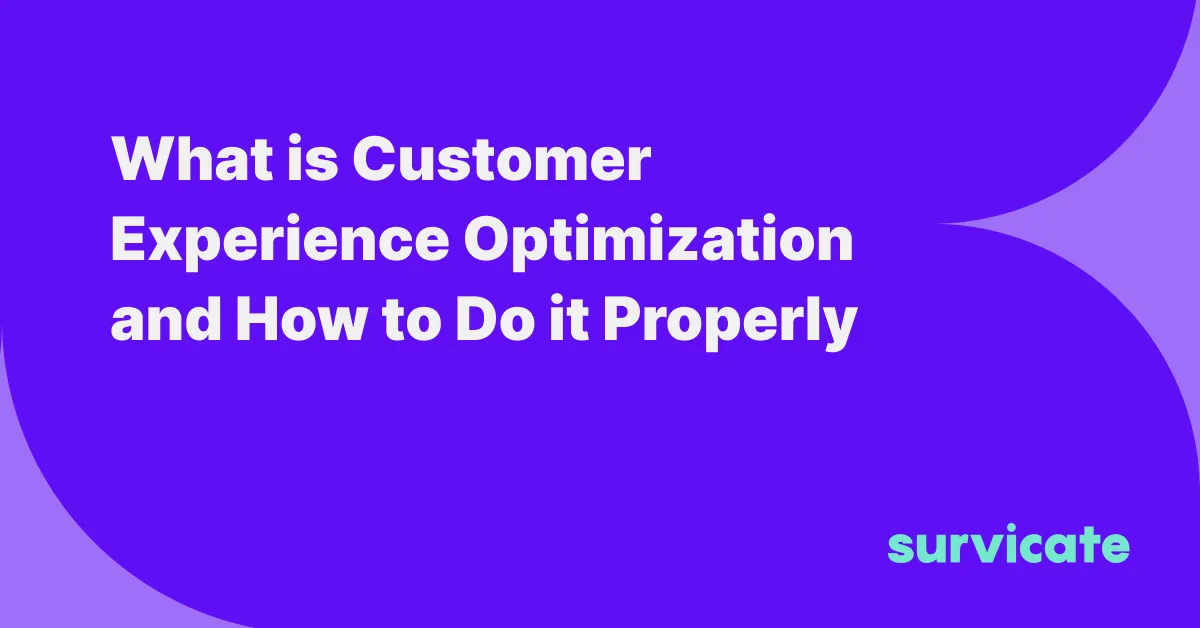

.webp)

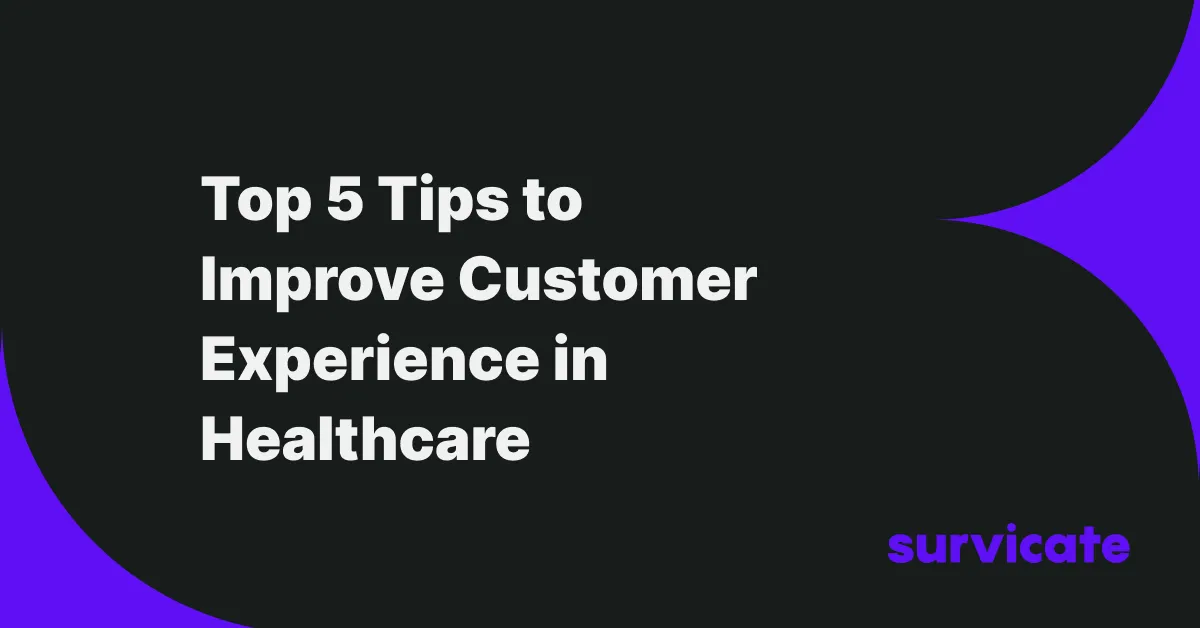
.svg)

.svg)



